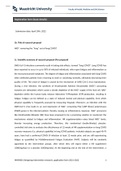Faculty of Health, Medicine and Life Sciences
Registration form (basic details)
Submission date: April 29th, 2022
1b. Title of research proposal
NAD⁺: removing the ‘’long’’ out of long COVID?
1c. Scientific summary of research proposal (Pre-proposal)
SARS-CoV-2 infections commonly result in lasting side-effects, termed “long COVID”. Long COVID has
been reported to occur in up to 30% of infected individuals, who report fatigue and inflammation as
the most pronounced symptoms. The degree of fatigue and inflammation associated with long COVID
often withholds patients from returning to work or socialising normally, ultimately decreasing their
quality of life. The onset of fatigue is caused by the mechanism of SARS CoV-2 virus reproduction.
During a viral infection, the synthesis of Nicotinamide Adenine Dinucleotide (NAD⁺) consuming
enzymes are stimulated, which causes a drastic depletion of the NAD⁺ supply of the host cell. NAD⁺
depletion within the human body reduces Adenosine TriPhosphate (ATP)-production, resulting in
fatigue. Fatigue can be defined as a state of reduced mental and physical capability, from which
physical capability is frequently assessed by measuring VO₂peak. Moreover, an infection with the
SARS-CoV-2 virus leads to an over-expression of NAD⁺ consuming Poly [ADP-ribose] polymerases
(PARP)-genes in the infected patient, thereby causing an inflammatory response. NAD⁺ precursors
like Nicotinamide Riboside (NR) have been proposed to be a promising solution to counteract the
mechanisms related to fatigue and inflammation. NR supplementation raises blood NAD⁺ levels,
thereby increasing energy production. Therefore, this randomised double-blinded, placebo-
controlled trial aims to evaluate the effectiveness of 12-weeks of NR supplementation on long COVID
recovery measures (i.e. physical capability) in long COVID patients. Included subjects are aged 40-70
years, have had a confirmed COVID-19 infection at least 12 weeks prior, and are still experiencing
fatigue as quantified by Multidimensional Fatigue Evaluation (MAF). Subjects will be randomly
appointed to the intervention groups, after which they will ingest either a NR supplement
(1000mg/day) or a placebo (1000mg/day). At the beginning and at the end of the intervention, a
HMS4001 Designing Intervention research_application form 2021-2022 1
, Faculty of Health, Medicine and Life Sciences
VO₂peak test is performed and blood and muscle samples are taken for cytokine and gene expression
analysis.
1d. Keywords
Long COVID; Fatigue; Inflammation; NR supplementation; NAD+
HMS4001 Designing Intervention research_application form 2021-2022 2
, Faculty of Health, Medicine and Life Sciences
Research proposal
2a. Background of proposed research
Most people who get infected with the SARS-CoV-2 virus, return to their baseline state of health
within 3 to 4 weeks. However, when an individual has recovered from acute COVID-19, but is still
experiencing symptoms 12 week post infection, long COVID is diagnosed (1). Globally, the prevalence
of long COVID, 90 and 120 days post infection, is estimated to be 0.32 and 0.49 respectively (2). This
means that almost half of the people who get infected with the virus, still experience symptoms after
120 day. Considering approximately 460 million COVID recoveries worldwide (3), this is equivalent to
225 million people worldwide. The most common symptoms in affected individuals include extreme
fatigue, shortness of breath, and cognitive dysfunction (4). Not only patients experiencing severe
symptoms during acute infection are subject to long COVID, but also those who are only moderately
ill or even asymptomatic are susceptible to long COVID (5). Long COVID can be a debilitating
condition, affecting the daily lives of these patients; e.g. not being able to return to pre-infection
level of working, and accompanying psychological problems (6). Since, according to the World Health
Organisation (WHO), there currently is no specific treatment available for long COVID (7), finding
effective therapies for long COVID treatment is essential.
The most common symptom of long COVID is fatigue, reported in 53.1% of the cases (8). Fatigue can
be defined as a state of reduced mental and physical capability (9). Long COVID associated fatigue
has been proposed to impact skeletal muscle metabolic capacity (10). This can be seen by a decrease
in VO₂peak as it has been observed in other diseases with fatigue as a main symptom (11). The drop
in VO₂peak has been explained by a decrease in intramuscular substrates. Nicotinamide Adenine
Dinucleotide (NAD⁺) is a key substrate for energy production. A depletion in the NAD⁺ pool reduces
Adenosine TriPhosphate (ATP)-production. It is suggested that NAD⁺ depletion causes the
pathogenesis of SARS-CoV-2 infection and its long-term consequences. In acute COVID patients, a
depletion of NAD+ levels has been reported. Specifically, lower amounts of the NAD⁺ precursor are
present in the blood of COVID patients compared to healthy individuals (12). This can be explained by
a few mechanisms. In order to reproduce itself upon cell-entry, the virus uses NAD⁺ from its host cell.
Furthermore, this virus modulates the intensity of the immune response by over-expression of
proinflammatory NAD⁺-consuming Poly [ADP-ribose] polymerases (PARP)-genes in the infected
patient (13). When host cells are infected with SARS-CoV-2, the immune system is hyperactivated,
activating cytokine storms (14). These cytokine storms are triggered by an uncontrolled inflammatory
HMS4001 Designing Intervention research_application form 2021-2022 3





